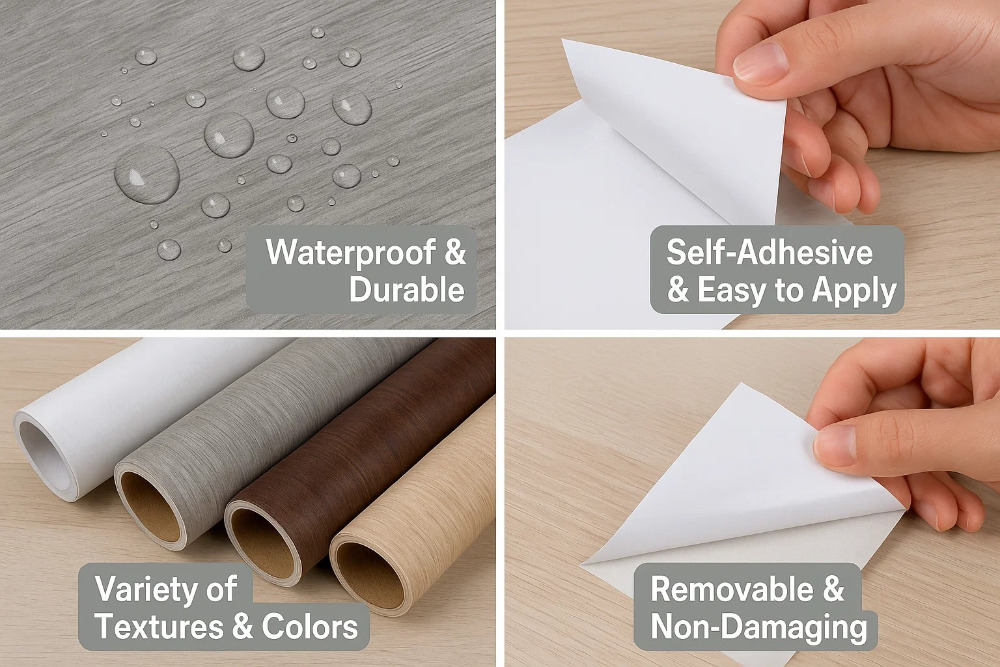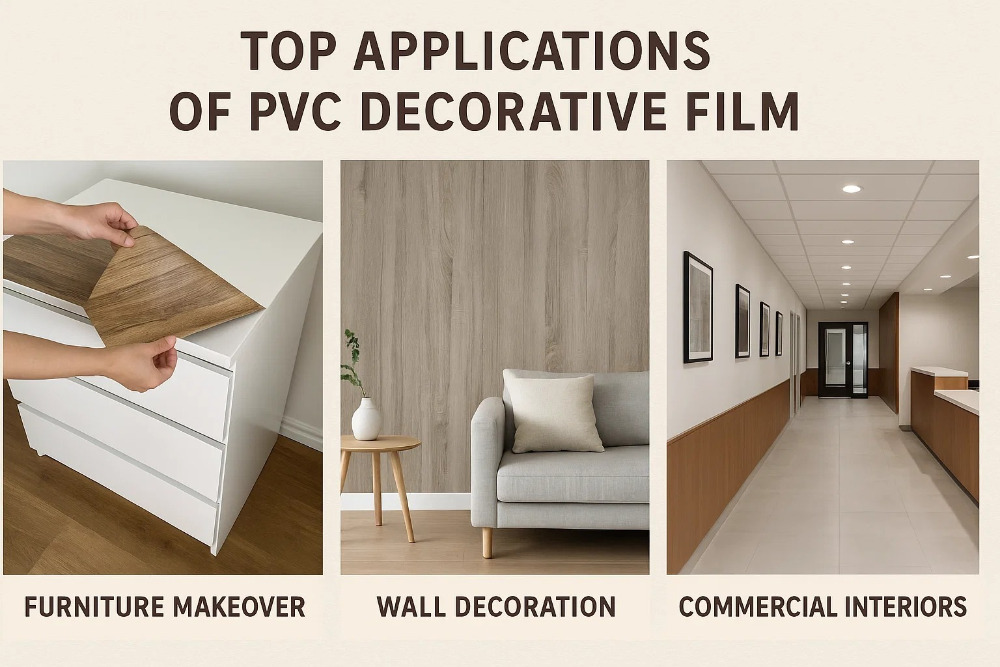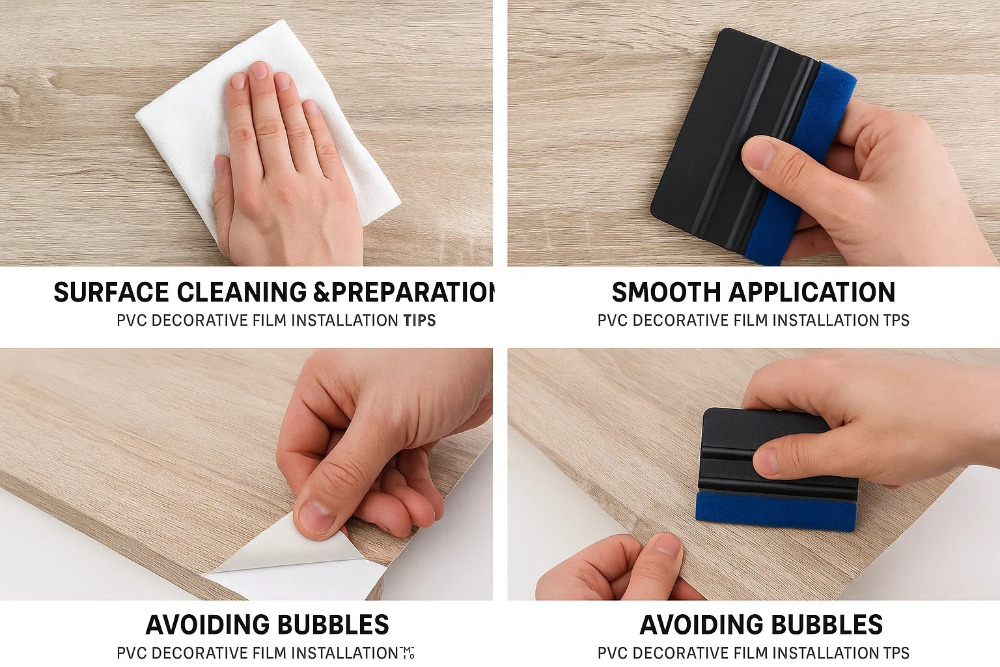To make the life more colorful
Introduction
PVC decorative film is a game-changer for transforming interiors without breaking the bank. This versatile material, short for Polyvinyl Chloride, offers a lightweight, waterproof, and highly customizable solution for giving surfaces a fresh new look. Forget messy paints or costly renovations; PVC film makes it easy to update everything from furniture to walls and cabinets.
Whether you're aiming for the classic warmth of wood grain PVC film for your kitchen cabinets, the sleek sophistication of metallic finishes for a modern living space, or even a bold pop of color, there’s a PVC decorative film to match your vision. It's a fantastic alternative to traditional materials, allowing for quick, clean, and impressive makeovers in both homes and commercial settings.
Features & Benefits of PVC Decorative Film

PVC decorative film stands out for a host of reasons, making it a popular choice for both DIY enthusiasts and professional designers.
Waterproof & Durable
One of the biggest advantages of PVC film is its excellent resistance to moisture. This makes it ideal for areas prone to splashes and spills, like kitchen cabinets and bathrooms. It's not just waterproof; it's also built to last, offering a durable surface that can withstand daily wear and tear, protecting the underlying material.
Self-Adhesive & Easy to Apply
Most PVC decorative films come with a self-adhesive backing, which means no messy glues or complex tools are required. This makes self-adhesive PVC film for furniture a go-to for simple DIY renovations. You can often just peel and stick, making installation straightforward and accessible even for beginners.
Variety of Textures & Colors
The design possibilities with PVC decorative film are virtually endless. You can find everything from matte PVC decorative film for a subtle, sophisticated look to high gloss finishes that reflect light and make a space feel brighter. Beyond a spectrum of colors, it comes in a vast array of textures, mimicking materials like wood, marble, stone, fabric, and even metallic effects, allowing you to achieve almost any design aesthetic.
Removable & Non-Damaging
For renters or those who like to change their decor frequently, removable PVC film is a dream come true. It's designed to be peeled off without leaving sticky residue or damaging the underlying surface. This means you can update walls or furniture without worrying about permanent alterations, offering incredible flexibility.
Top Applications of PVC Decorative Film
The versatility of PVC decorative film means it can be applied in numerous creative ways to refresh and transform various spaces.

Furniture Makeover
One of the most popular uses for PVC decorative film is giving old furniture a completely new lease on life. Instead of buying new pieces, you can easily give old cabinets a new look with wood grain PVC film, transforming them from dated to dazzling. It's an incredibly affordable alternative to refinishing wooden furniture, saving you both time and money. Think beyond cabinets; DIY furniture PVC film is perfect for tabletop renovation, dressers, bookshelves, and even doors.
Wall Decoration
Beyond furniture, PVC film offers an exciting way to revitalize walls. You can create accent walls with textured PVC film for 3D effects, adding depth and visual interest to a room. Craving luxury? Marble effect PVC film adds luxury without the cost of real stone, allowing you to achieve a high-end look in living rooms, bedrooms, or even bathrooms. The peel-and-stick wall film makes it an incredibly user-friendly option for anyone looking to update their interiors quickly and easily.
Commercial Interiors
PVC decorative film is also a smart choice for commercial spaces, where quick and cost-effective updates are often necessary. It's widely used in hotels, offices, and retail spaces for quick branding updates or complete aesthetic overhauls. For cafes and restaurants, heat-resistant PVC film for countertops provides a durable and stylish surface that can withstand daily use, making it a practical and attractive solution for high-traffic environments. Durable decorative film for shops can also be used on display units, reception desks, and other fixtures to maintain a fresh and inviting atmosphere.
How to Choose PVC Decorative Film (Buying Guide)
Selecting the right PVC decorative film for your project ensures the best results. Here's what to consider:
Material Type
Matte: Offers a sophisticated, non-reflective finish that hides minor imperfections.
Glossy: Provides a high-shine, reflective surface that brightens spaces and looks sleek.
Textured: Mimics the feel and look of natural materials like wood, stone, or fabric, adding tactile interest.
Transparent: Ideal for protecting surfaces while allowing the original material to show through, often with a subtle pattern or tint.
Adhesive Strength
Permanent: Designed for long-term applications, offering a strong, durable bond.
Removable: Perfect for temporary decor, renters, or seasonal changes, as it can be peeled off without damaging the surface.
Temperature Resistance
If you're planning to use PVC film in areas exposed to heat, such as near stovetops or on kitchen countertops, opt for heat-resistant PVC film for kitchens. These films are formulated to withstand higher temperatures without bubbling, peeling, or discoloring.
Installation Tips

Applying PVC decorative film successfully requires a bit of preparation and technique. Follow these tips for a smooth, bubble-free finish:
Surface Cleaning & Preparation
Before you begin, ensure your surface is clean and dry. Dust, grease, or debris can prevent the film from adhering properly and might create unsightly bumps. Use a mild cleaner and let the surface dry completely. For porous surfaces, a primer might be recommended.
Smooth Application & Avoiding Bubbles
Measure and Cut Accurately: Measure your surface carefully and cut the film a little larger than needed. You can trim the excess later for a perfect fit.
Peel Gradually: Don't remove the entire backing all at once. Peel back a small section (e.g., 2-3 inches) from one edge.
Start from One Side: Align the exposed edge of the film with your starting point on the surface.
Use a Squeegee for Smooth Application: As you slowly peel off more of the backing, use a squeegee (a plastic tool with a felt edge is best) to press the film down, working from the center outwards or from one side to the other. This helps push out any air bubbles as you go.
Patience is Key: If you see a bubble forming, gently lift the film back to that point and reapply, pushing the air out with your squeegee. For stubborn small bubbles, you can prick them with a fine needle and then smooth them down.
Trim Excess: Once the film is fully applied, use a sharp utility knife to carefully trim any excess film around the edges for a clean, professional look.
Frequently Asked Questions (FAQ)
Got questions about PVC decorative film? We've got answers to some of the most common inquiries to help you make informed decisions for your projects.
Q:Can PVC decorative film be used outdoors?
A:Generally, most decorative PVC films are designed for indoor applications. While some specialized, more durable films exist for exterior use, regular decorative film isn't made to withstand constant exposure to UV rays, rain, and extreme temperatures. Using it outdoors will likely lead to fading, cracking, and peeling over time.
Q:Is PVC film safe for kitchen countertops?
A:Yes, high-quality PVC film can be safely used on kitchen countertops. When choosing for this area, specifically look for heat-resistant PVC film that is designed for surfaces that might encounter warmth. While it's durable, it's always a good idea to use trivets under extremely hot pots and pans to protect the film and extend its lifespan.
Q:How long does self-adhesive PVC film last?
A:The durability of self-adhesive PVC film varies significantly based on the product's quality, how well the surface was prepared, and the amount of wear and tear it experiences. With proper application and care, a good quality film can last anywhere from 5 to 10 years or even longer in areas with less traffic. Factors like direct sunlight or constant moisture can affect its longevity. To ensure the best results, research waterproof PVC film durability for specific products you're considering.
Q:What's the difference between PVC film and vinyl wrap?
A:While the terms are often used interchangeably, there's a subtle distinction. PVC film typically refers to decorative films designed for interior surfaces like furniture and walls. Vinyl wrap, on the other hand, often implies a more robust and conformable material, commonly used for vehicle wraps or durable outdoor signage. Both are made from types of plastic, but their specific formulations and intended applications can differ. For interior decor, you'll generally be looking for PVC film.
Conclusion
PVC decorative film offers an exciting, cost-effective, and surprisingly simple way to breathe new life into your spaces. Its affordability, ease of installation, and incredible versatility make it an unparalleled choice for anyone looking to refresh their home or commercial environment. From transforming dated furniture with DIY furniture PVC film to creating stunning accent walls and durable commercial surfaces, the possibilities are vast.
With an expansive range of wood grain and marble PVC films, solid colors, and unique textures available, you can achieve nearly any design vision without the commitment or expense of traditional renovations. It’s a practical, stylish, and adaptable solution for modern living.
Ready to start your next project? Explore our collection of wood grain and marble PVC films today and unlock the potential of your interiors!

 English
English русский
русский
















